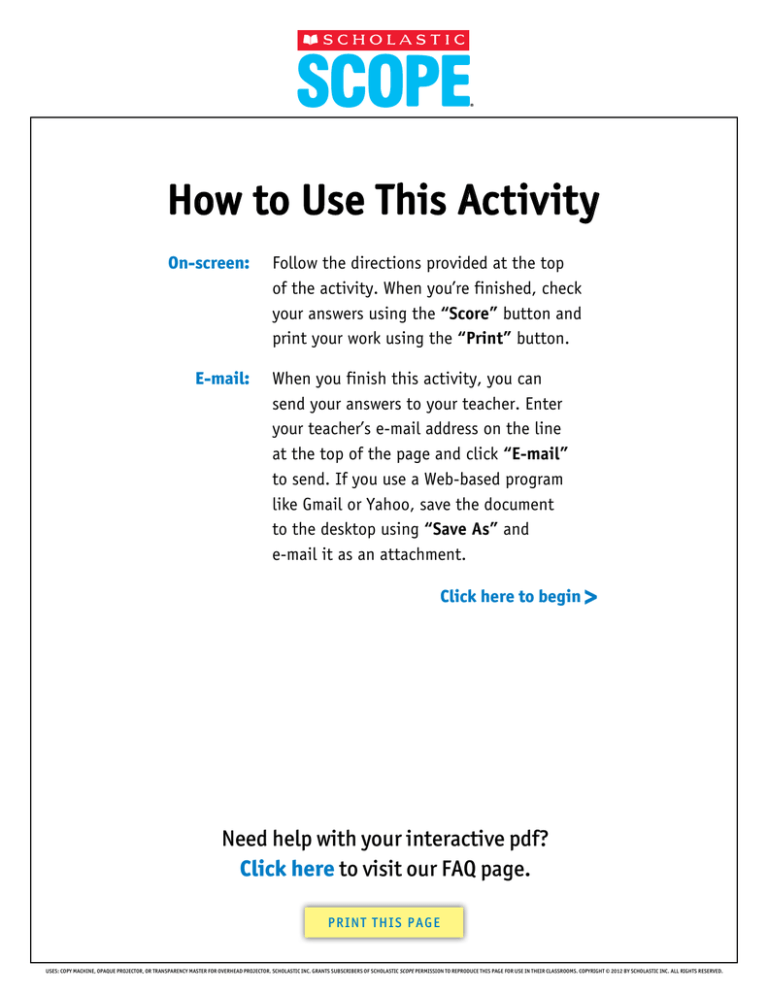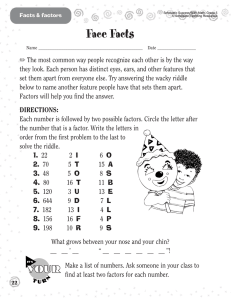
®
®
READWRITETHINKCONNECT
THE LANGUAGE ARTS MAGAZINE
TM
How to Use This Activity
®
READWRITETHINKCONNECT
TM
®
READWRITETHINKCONNECT
TM
On-screen:Follow the directions provided at the top
of the activity. When you’re finished, check
your answers using the “Score” button and
READWRITETHINKCONNECT
READWRITETHINKCONNECT
print your work using the “Print” button.
®
®
TM
TM
E-mail:
When you finish this activity, you can
send your answers to your teacher. Enter
your teacher’s e-mail address on the line
at the top of the page and click “E-mail”
to send. If you use a Web-based program
like Gmail or Yahoo, save the document
to the desktop using “Save As” and
e-mail it as an attachment.
Click here to begin >
Need help with your interactive pdf?
Click here to visit our FAQ page.
P r i nt T h i s pa g e
Uses: Copy machine, opaque projector, or transparency master for overhead projector. Scholastic Inc. grants subscribers of Scholastic Scope permission to reproduce this page for use in their classrooms. Copyright © 2012 by Scholastic Inc. All rights reserved.
Name: ____________________________________________________ Date: _____________
®
READWRITETHINKCONNECT
NE
Your teacher’s
e-mail (optional): ________________________________________________
®
E-MAIL
TM
NONFICTION: “The Blood-Red Night” • Skill: Assessment, HL
“The Blood-Red Night” Quiz
®
CT
TM
®
CT
TM
Directions: Read “The Blood-Red Night”on pages 4-8 of the December 2014 issue of Scope. Then click the bubble next to
the BEST answer for each question below.
®
READWRITETHINKCONNECT
TM
1. Which of the following best expresses a central
idea of “The Blood-Red Night”?
A In the 1860s, many immigrants moved west to
READWRITEsettle
THINK
CONNECT
new
land.
B The Great Peshtigo Fire of 1871 was a
devastating wildfire.
C John Kramer was 7 years old when the Great
Peshtigo Fire occurred.
D In the late 19th century, American cities were
growing fast.
4.Lauren Tarshis writes that lumber companies
“sent out armies of lumberjacks to chop down
trees . . . .” She probably uses the word armies to
suggest that the lumberjacks
A slept in barracks like soldiers.
B were fighting a losing battle.
C were riding on horseback.
D were aggressive and large in number.
®
TM
2.Which of the following lines best supports your
answer to question 1?
A “And what a wilderness it was!” (p. 5)
B “October 8 dawned unnaturally hot.” (p. 7)
C “By morning, more than a billion trees were
gone, and an area twice the size of Rhode Island
was nothing more than a sea of charred trees
and ash.”(p. 8)
D “The Kramers decided to stay and help rebuild.”
(p. 8)
3.The author uses the quote by Laura Ingalls
Wilder on page 5 to
A demonstrate the challenges of pioneer life.
B contrast the Kramers’ description of the forest.
C emphasize the vastness of the forest.
D support the claim that the Peshtigo Fire was the
worst fire in U.S. history.
5.On page 8, Tarshis describes the landscape after
the fire as “a sea of charred trees and ash.” This
metaphor tells you that
A the land was underwater.
B the area of forest that burned was vast.
C people were fishing for their belongings.
D the land smelled like salt water.
6.Tarshis likely wrote “The Blood-Red Night” for all
of the following reasons except
A to fascinate the reader with a captivating story
of survival.
B to inform the reader about the Great Peshtigo
Fire.
C to educate readers about the connection
between human activity and the environment.
t
D o explain why the Great Chicago Fire was so
devastating.
Constructed-Response Questions Begin on Next Page ➤
SAVE AS
Star t Over
SCORE
©2014 by Scholastic Inc. Teachers may project or make copies of this page to distribute to students.
Print
Name: ____________________________________________________ Date: _____________
®
®
READWRITETHINKCONNECT
NE
Your teacher’s
e-mail (optional): ________________________________________________
E-MAIL
TM
NONFICTION: “The Blood-Red Night” • Skill: Assessment, HL
“The Blood-Red Night” Quiz
®
TM
Directions: Type your answers into the space below. Use complete sentences.
®
READWRITETHINKCONNECT
TM
7.What is the purpose of the section “Chop, Chop, Chop”? In other words, what does it contribute to the text? Support
your answer with details from the text.
®
CT
TM
®
READWRITETHINKCONNECT
TM
8.Trace a chain of causes and effects that led to the Peshtigo Fire. Use text evidence to support your answer.
➤
CT
Return to Multiple-Choice Questions
SAVE AS
Star t Over
SCORE
©2014 by Scholastic Inc. Teachers may project or make copies of this page to distribute to students.w
Print

